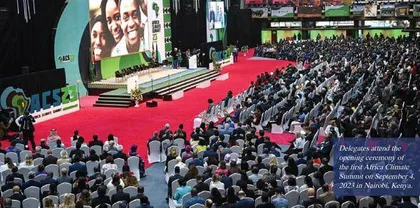The Strength of the Global South in Addressing Climate Change
作者: Chen Ying

According to State of theGlobal Climate 2022 and Pro-visional State of the Global Climate 2023 published by the World Meteorological Organization, the global mean temperature in 2022 was 1.15°C above the 1850–1900 average, the years 2015 to 2022 were the eight warmest on record, and the year 2023 was the warmest year on record. It is imperative to address the global cli- mate crisis since it is posing increas- ing challenges to the ecosystem and sustainable socio-economic develop- ment of human society. The global climate governance has weathered ups and downs over the past 30 years. In this process, boundaries between the North and the South camps have been blurred with the rise of internal division. The Global South has andwill continue to play an important role in improving the global climate governance.
ROLES PLAYED BY THE GLOBALSOUTH IN GLOBAL CLIMATEGOVERNANCE
The concept of the Global South was first proposed by Carl Oglesby, an American left-wing political activ- ist, during the Cold War. It initially referred to the vast number of devel- oping countries that are distinct from the Western countries. However, this concept has been greatly enriched in global climate governance.
First, it refers to all developing countries. Countries are mainly cat- egorized into two groups in climate negotiations, thus leading to North- South divide in global climate gov- ernance. The United Nations Frame- work Convention on Climate Change (UNFCCC) adopted in 1992 at the UN Conference on Environment and Development (UNCED) entered into force in 1994. With a total of 198 parties, the Convention is one of the in- ternational environmental laws with the widest coverage. The UNFCCC divides countries into Annex I Parties (developed countries and countries with economies in transition) and non-Annex I Parties (developing countries) and sets out different obli- gations for different groups. It is em- phasized that Annex I Parties should take the lead in reducing emissions and provide non-Annex I Parties with financial and technical assistance. To realize the objectives of the UNFCCC, COP3 held in 1997 adopted the Kyoto Protocol, for the first time setting out quantitative emission reduction obligations for developed countries and countries with economies in transition (CEIT). Although develop- ing countries were not subject to any quantitative emission reduction obli- gations, they pledged to control the greenhouse gas emissions throughimplementing sustainable develop- ment policies.
Second, it refers to the Group of 77(G77) and China. Established in 1964, the G77 currently has 133 mem- bers. It has long been committed to strengthening solidarity and coopera- tion among developing countries, pro- moting the building of a new interna- tional economic order, and advancing socio-economic development of developing countries. At the prepara- tory meeting for the UNCED in 1991, the G77 and China published their first joint position paper. Since then, the cooperation mode of “the G77 and China” has gradually emerged in other areas including socio-economic development, UN finance and budg- et, and climate change. As representa- tives of the Global South, the G77 and China have participated in various climate negotiations and played a significant role in improving global climate governance.
Third, it refers to various mecha- nisms established by developing countries for addressing climate change. As the landscape of global cli- mate governance evolves, the North and the South camps have been fur- ther divided by their positions, and various organizations and mecha- nisms have thus been formed such as the BASIC (Brazil, South Africa, India, China), the Like-Minded Developing Countries (LMDC), the Least Devel- oped Countries (LDCs), and the Alli- ance of Small Island States (AOSIS). Countries of these organizations have gradually formed a common stance through regular exchanges, and ac- tively safeguarded their own interests in global climate negotiations. There is also overlap between different groups. For example, 10 countries in the AOSIS are alsoLDCs.
Fourth, it refers to regional or functional organizations established by developing countries, including the African Union (AU), the Bolivarian Alliance for the People of Our America (ALBA) and the Organization of the Pe- troleum Exporting Countries (OPEC). They represent the interests of their re- spective regions or groups and express a coordinated and consistent position in global climate governance.
HISTORICAL CONTRIBUTION OF THE GLOBAL SOUTH TO GLOBAL CLIMATE GOVERNANCE
There are three landmark events in intergovernmental climate negotia- tions since 1990, and the Global South has played an important role in im- proving global climate governance.
First,the Global South has promot- ed the adoption and entry into force of the UNFCCC, establishing basic principles and laying an important legal foundation for global response to climate change. During the nego- tiation of the Convention, there was a binary distinction between developing and developed countries. For devel- oped countries, on the one hand, they attempted to play down or even evade their historical responsibilities and delay the fulfillment of their obliga- tions to offer technological and finan- cial support. On the other hand, they asked developing countries to reduce emissions. For developing countries, they strived to defend their own devel- opment rights and interests, empha- sizing that eradicating poverty and im- proving people’s livelihoods were their top priority. Meanwhile, they stressed that developed countries should take the lead in cutting emissions and ful- fill their obligations to offer financial assistance and technology transfer to developing countries. After rounds of negotiations, the UNFCCC was adopted. The Convention formalizes five principles including to act on the basis of equity and in accordance with common but differentiated responsi- bilities and respective capabilities, and to promote sustainable development.The Convention divides countries into Annex I and non-Annex I Parties, and sets out common but differentiated responsibilities, striking a balance be- tween different parties’ pursuit.